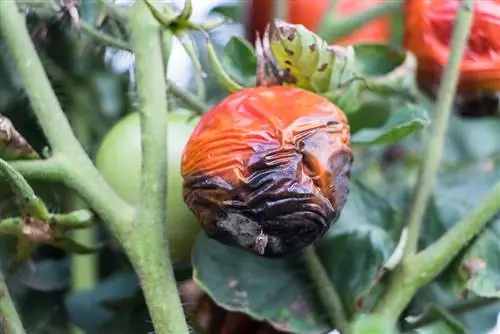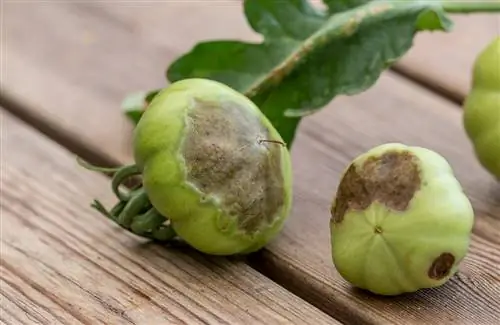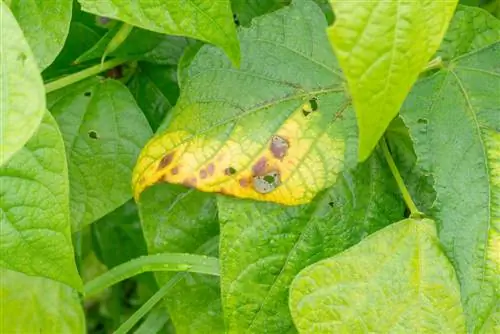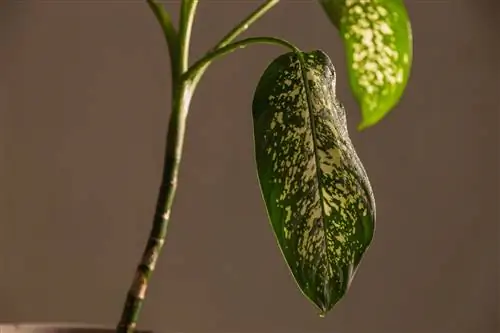- Author admin [email protected].
- Public 2023-12-16 16:46.
- Last modified 2025-01-23 11:22.
Dark brown to black spots on tomato fruits and leaves indicate a variety of diseases. Depending on the state of the disease, your plants will be treated differently.

Why do my tomatoes have black spots?
Black spots on tomato fruits and leaves can indicate various diseases such as blossom end rot, late blight or phosphorus deficiency. In order to treat the plant appropriately, the affected parts must be examined and the cause determined.
What do black spots on tomatoes mean?
Depending on which parts of the plant there are black spots, different diseases can be the cause. The most common black spot diseases include late blight, blossom end rot, and calcium or phosphorus deficiency. If there is an over or under supply of nutrients, care for the plant with appropriate fertilizer and a regular supply of water. You should completely remove tomato plants with late blight.
Black spots on tomatoes and leaves: three possible diseases
The causes of black spots on the fruits and leaves of the tomato plant are varied. Therefore, in order to correctly determine the tomato disease and subsequent treatment, a comprehensive examination of the entire bush is required. Also find out about brown spots on tomatoes and yellow leaves on tomato plants.
Blossom end rot
Blossom end rot is one of the most common diseases of fast-growing vegetable plants, which include tomatoes, peppers and zucchini.
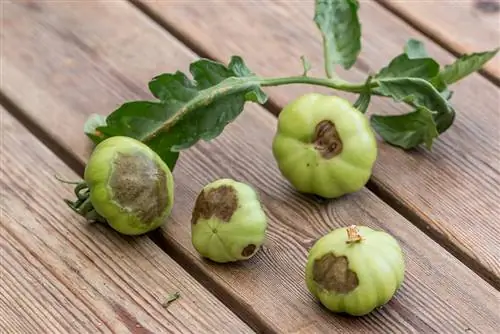
Blossom end rot can be recognized by sunken and dark areas on the fruit
Damage and identifying features
Leaves: The leaves are usually less affected by the rotting processes. Nevertheless, in addition to the formations on the fruits, there are slight deformations on the leaves on the same shoot.
Fruits: Blossom end rot particularly affects the ripening tomatoes, which have a brown to black spot around the base of the blossom. Over time, the spot continues to grow in size and collapse inward.
Calcium deficiency as a trigger
The mineral calcium is essential for the structure of cell membranes and thus the structure of fruits and leaves. Due to the plant's internal conduction systems, the supply of the leaves is preferred over that of the fruits. This means that the deficiency symptoms can primarily be identified in the tomatoes themselves. In addition to a pure calcium deficiency, other causes can also lead to reduced uptake by the tomato plant:
- excessive potassium or magnesium concentration
- Soil pH value highly acidic
- unbalanced fluid balance of the plant
Fertilizing with calcium and other home remedies
In order to compensate for an existing calcium deficiency as quickly as possible, the following remedies have proven to be effective in practice:
| Medium | Definition | Application |
|---|---|---|
| Algae limestone | lime fertilizer made from corals and algae | is scattered around the plant in powdered form, after which vigorous watering is required |
| Calcium effervescent tablets | chemically produced tablets | crushing the tablets into powder and then incorporating them into the soil |
| Calcium Carbonate | known as garden lime, concentrated calcium compound | sprinkle in powdered form around the plant, then water vigorously |
| Eggshells | empty eggshells, which should be free of protein residues | Soak the crushed shells of two to three eggs in a liter of water for several days, water the plant with the broth |
| Rock flour | made from bas alt or granite | sprinkle in powdered form around the plant, then water vigorously |
Immediate measures
Underserved fruits that already have discolored areas should be removed from the plant. In addition, you should briefly supply the plant with one of the aforementioned calcium sources and ensure appropriate irrigation. This allows the plant to nourish the fruits that are still ripening and to avoid infection with other diseases.
Prevention
The basis for defending against blossom end rot is a he althy tomato plant that has an intact immune system. In addition to correct care in terms of location selection and irrigation, fertilization in particular plays a crucial role. The administration of a special fertilizer (€14.00 at Amazon), which has a high proportion of calcium, is a proven preventative measure in addition to a complete fertilizer.
Blight and brown rot
Blight of tomatoes is a fungal disease that occurs particularly in tomato plants grown outdoors.
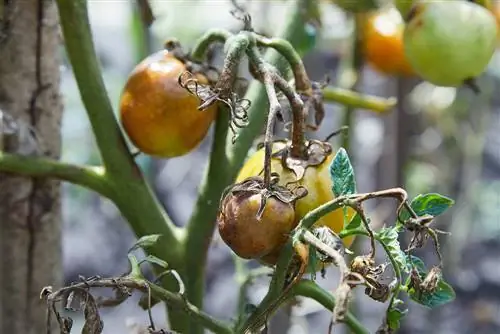
Eye blight extends to both the leaves and fruits of the tomato plant
Damage and identifying features
Leaves: The first signs of the fungal disease can be seen on the leaves, which form misshapen brown-black spots. In addition, a white down can often be seen on the underside of the leaves, which is also commonly known as fungal growth. As the disease progresses, the leaves wilt and then dry completely.
Fruits: The fruits are only affected by late blight in an advanced stage. Symptomatically, the disease can be recognized by rotten and mushy spots around the tomato, which have a brownish to grayish color.
Trigger
The cause of late blight lies in the spread of Phytophthora infestans fungal spores through wind and rain. Basically, the pathogens can be found in almost every substrate, although they are inactive in the soil most of the time. When the spores are stirred up by strong gusts of wind or heavy rain, they reach the leaves and fruits of the tomato plant and infect them.
Immediate measures
The affected plant parts should be disposed of with residual waste. You should refrain from adding it to the compost to avoid reinfection. In addition, the plant should be completely defoliated. The tools used for pruning should be thoroughly cleaned before the next use in order to prevent infections on other plants. Fighting with a fungicide is often no longer successful if symptoms are already visible.
Prevention
In order to keep the spread of spores as low as possible during the tomato's growth cycle, a location protected from wind and rain should be chosen. When planting and caring for it, you should therefore pay attention to the following instructions:
- Growing in a sheltered location such as a greenhouse
- Minimum distance of 50 cm between the individual plants
- water only with a soft jet of water and directly on the root ball to avoid splashing water
- Application of a potassium-containing fertilizer to strengthen the plant tissue
Phosphorus deficiency
The mineral phosphorus is essential for almost all metabolic processes in the tomato plant. In addition to its function as an energy source, which is important for the development of flowers and fruits, phosphorus also serves as a building block of DNA.
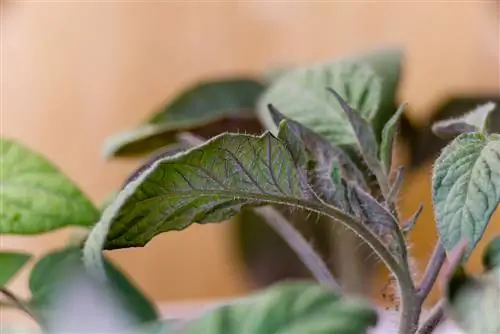
A phosphorus deficiency can be recognized by the purple-black discoloration of the leaves, which runs from the outside to the inside
Damage and identifying features
Leaves: A phosphorus deficiency can be clearly recognized visually by the purple discoloration of the leaves, which extends from the edge of the leaf into the interior. This is often accompanied by overall poor growth of the leaves in combination with deformations.
Fruits: If there is a persistent phosphorus deficiency, in most cases neither flowers nor fruits will form on the bush. If you do find a few tomatoes, they usually have a small and gaunt shape.
Trigger
The most common cause of a phosphorus deficiency is an insufficient supply of the mineral. Heavy eaters in particular, to whom the tomato plant is botanically assigned, need a consistently high amount of vital nutrients for constant growth and a lush harvest. If you provide your tomatoes with sufficient fertilizer containing phosphorus, deficiency symptoms can also arise from insufficient nutrient absorption capacity. This can be caused by an outside temperature that is too low, but also by soil that is too acidic.
Immediate measures
If an undersupply of phosphorus cannot be completely ruled out, the plant should be supplied with a slightly increased dose as a first step. Applying a liquid fertilizer directly to the leaves should prevent further leaves from discoloring. The already discolored leaves do not necessarily have to be removed from the plant, as these do not affect the emergence of new, he althy leaves. In addition, a separate cold protection is also recommended, which protects outdoor plants in particular from the cool temperatures at night.
Prevention
To avoid reduced nutrient uptake due to cold, tomatoes should not be planted before mid-May or after the Ice Saints. If temperatures are cool at night, a cover made of jute or fleece can also help. In addition, a possible phosphorus deficiency should be counteracted at an early stage by ensuring an adequate supply of nutrients when planting. Various natural fertilizers are suitable for both initial fertilization and ongoing fertilization. In addition to phosphorus, the fertilizers listed below also contain many other essential minerals.
- Ashes
- Guano
- Horn shavings
- Horse manure
Other recommended phosphorus fertilizers can be found here.
To eat tomatoes with black spots or not?
Blossom end rot:Despite the unappetizing dark spots, tomatoes infected with blossom end rot are stilledible without any problems. However, you should cut out the relevant areas generously before consumption.
late blight:As soon as the late blight spreads to the fruits of the tomato plant, they areno longer edible. The putrefactive processes are accompanied, among other things, by a loss of taste, which makes them inedible.
Phosphorus deficiency:Basically, the tomatoes from plants that are contaminated with a phosphorus deficiency areedible. In acute deficiency symptoms, however, the shrub often produces no fruit at all or only produces very small fruits.
Prevent tomato diseases with nettle manure
The nettle manure is known for its high effectiveness in warding off pest infestations. This is primarily due to the concentration of the minerals nitrogen and potassium as well as silica, which also strengthen the plant's immune system.
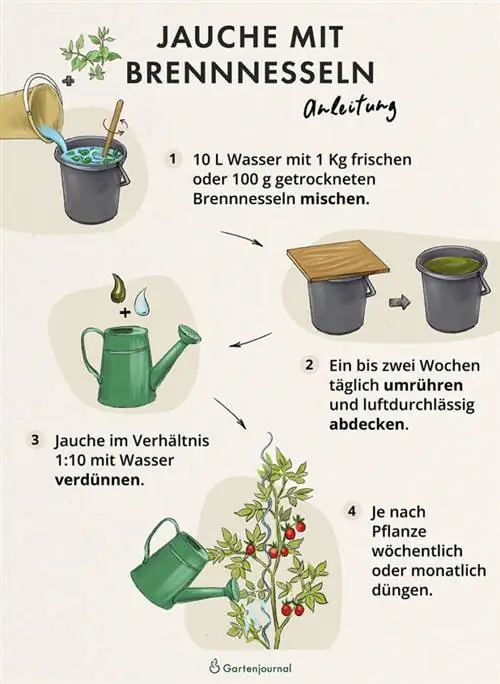
The production and use of nettle manure can be done in just a few simple steps:
- Pour 1 kilogram of fresh nettles into 10 liters of rainwater in a bucket and stir vigorously
- Cover the bucket with a wooden plate or something similar to protect the brew from environmental influences
- Stir the mixture daily for one to two weeks until no more bubbles appear - done!
The manure should never be administered undiluted to avoid over-fertilizing the plant. A dilution in a ratio of 1:10 with rainwater and a maximum of two weeks is completely sufficient.
FAQ
What helps with blossom end rot?
An advanced disease with blossom end rot can no longer be treated on the parts of the plant that have already been affected. It is therefore advisable to remove the externally changed fruits from the plant as quickly as possible and to supply the bush with a calcium-containing fertilizer.
Are tomatoes with black spots edible?
The extent to which black-spotted tomatoes are still edible depends on the respective disease. While blossom end rot and phosphorus deficiency have no influence on edibility, fruits affected by late blight should no longer be eaten.
Why do tomatoes get black spots?
The causes of discoloration of tomatoes are varied, but in most cases it is related to improper care of the plant and a resulting illness.
What can I do about black spots on tomatoes?
Tomatoes that have already discolored cannot be returned to their original state. However, by taking preventative measures such as applying fertilizers containing calcium and phosphorus, choosing the right location and overall care adapted to the tomato variety, any illnesses can be avoided.

